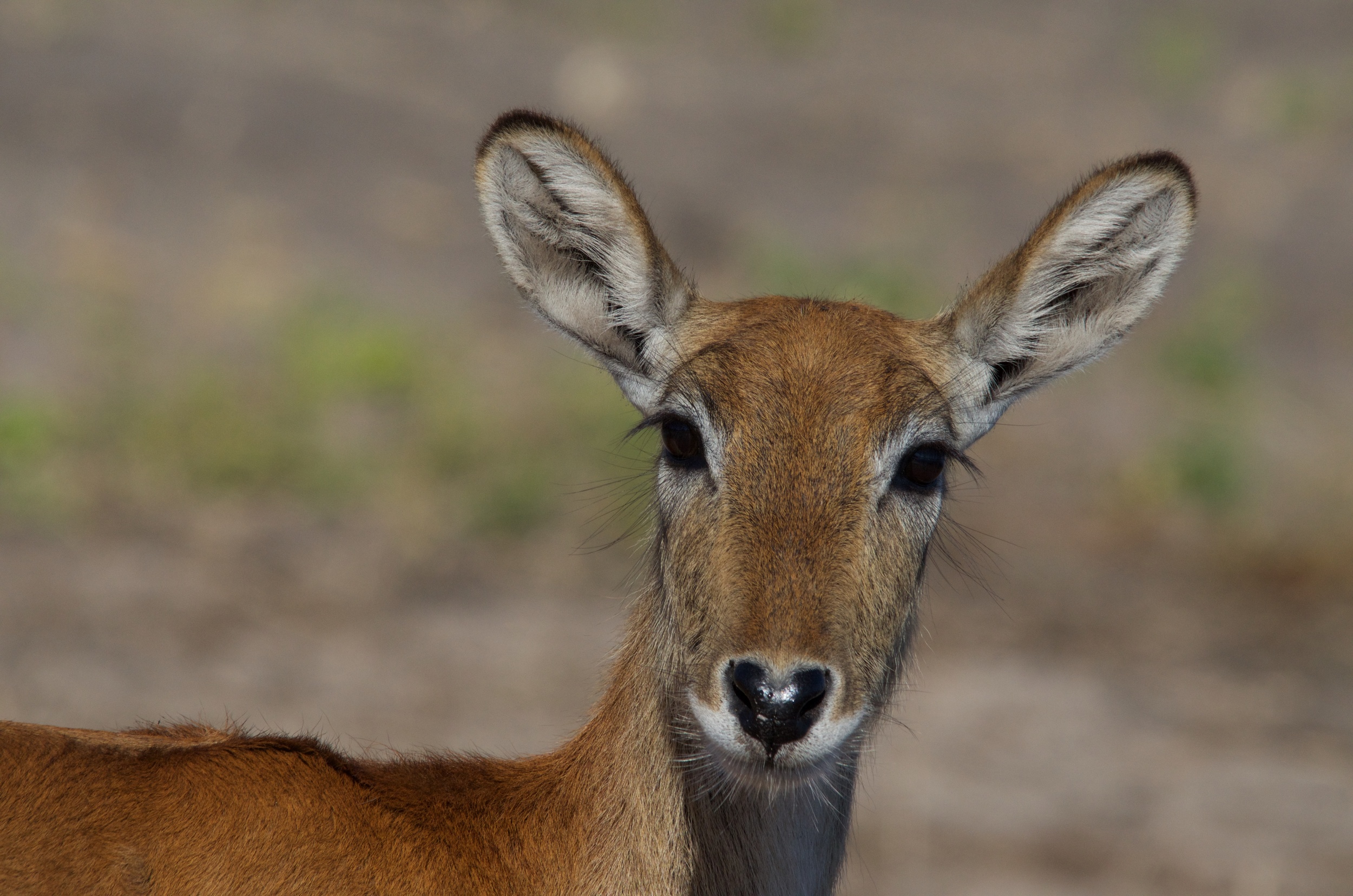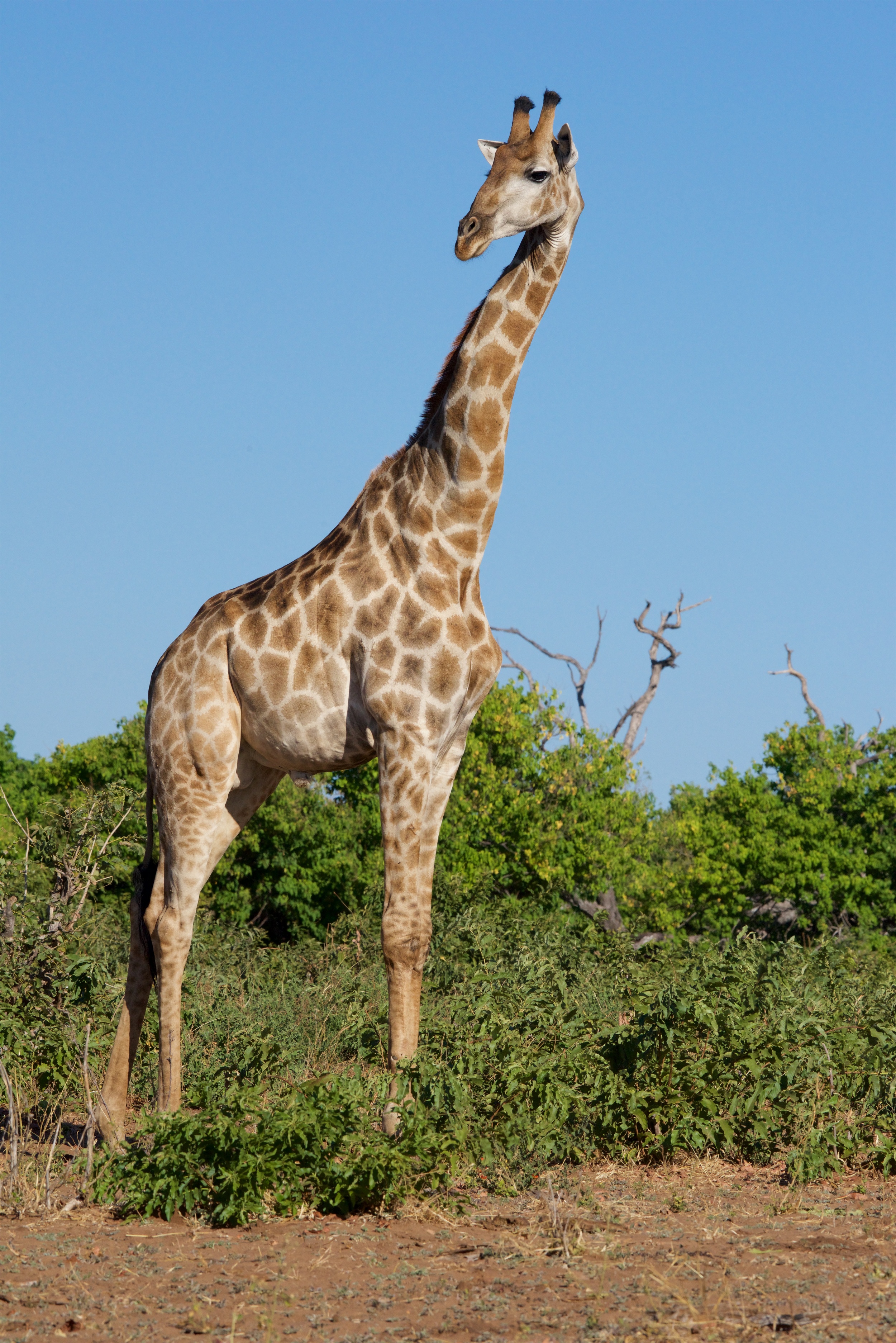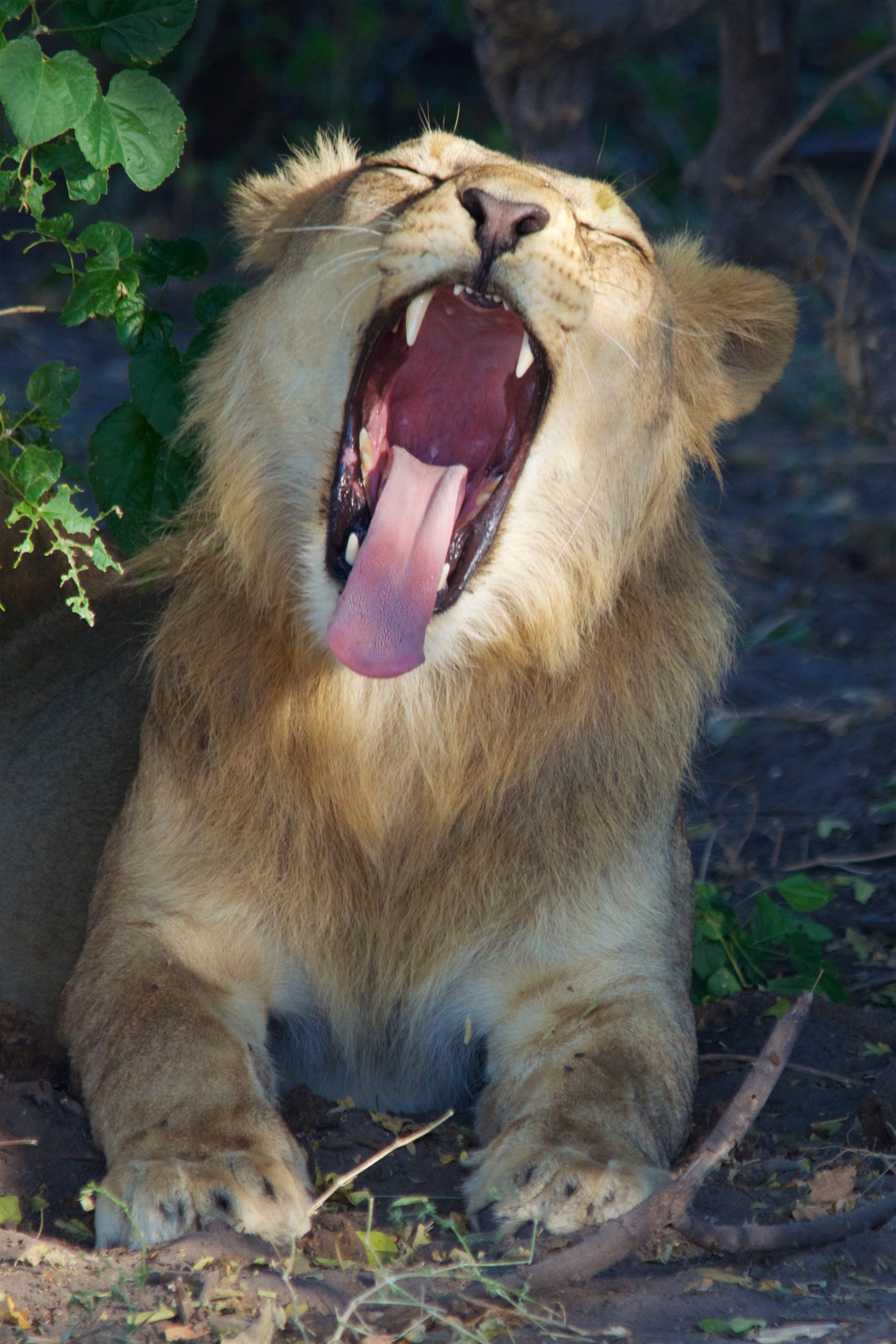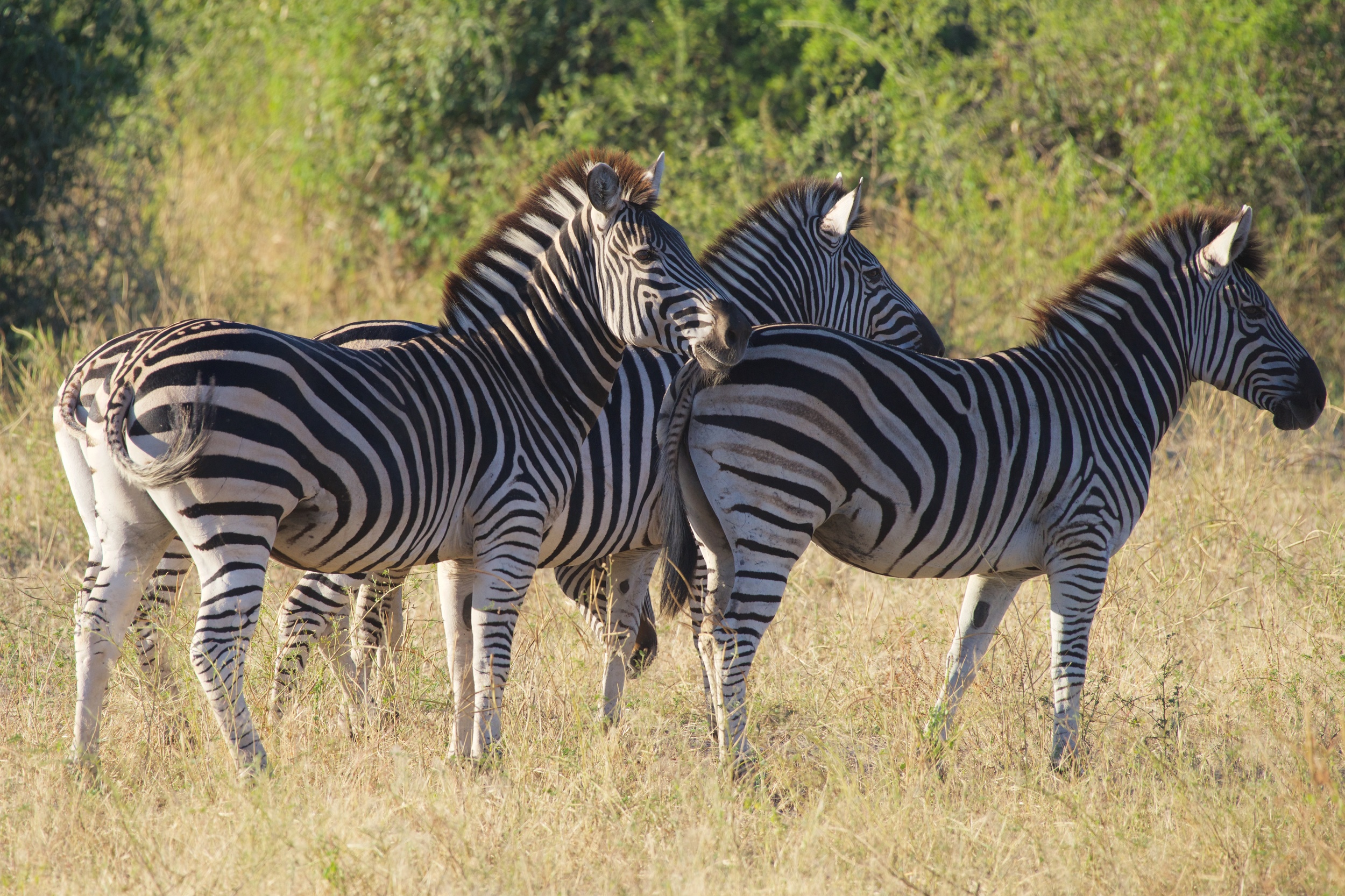At 0630 Charl picked us up and we drove through the very small township of Kasane to a nearby luxury resort where our boat was moored overnight. Our group of six plus Charl and Shar then headed eastwards towards the rising sun and down the Chobe River towards the rapids.
Until this morning we’d only been in the open flood plane section of the river but the area we now entered was where the river was more constrained by the smaller separation of the banks. With the river now being only about 200m wide the current become very noticeable and the turbulent water and frequent eddies meant that handling the boat was to require great skill. Shar did superbly and took us down stream to a point where with the sun now rising we were to experience a spectacular sight.
In the middle of the river with fast flowing water on either side was a tall partially dead tree covered with vines. In this tree was a nesting colony of yellow-billed storks and the action amongst these hundreds of big birds was frenetic.
Shar with consummate skill managed to position the boat in the current with the engine in gear running so that we were stationary relative to the nearby nesting tree.
Nesting yellow-billed storks on island
For close to an hour we stayed pretty much in this fixed location and observed the behaviour of these graceful birds. Many of the storks were already sitting on nests made from sticks, twigs and greenery gleaned for the nearby bushes on the riverbank. Some pairs of storks were still in the process of building nests and the high density of bird-life meant that there were on-going squabbles over real estate issues. Disputes between storks usually resulted in the clashing of their long yellow beaks in a manner resembling epees in fencing duels.
African spoonbill in flight
Pink backed pelican
Storks were frequently departing and returning to the colony often bringing in nest building materials. Being in their breeding plumage meant that the storks have deep red faces and their wings were tinged with pale pink feathers.
Yellow-billed stork
One of the challenges was to get sharp photos of the birds in flight and with so many to practise on, we soon achieved a reasonable degree of success in this endeavour.
Apart from the storks that comprised 90% of the tree’s population there were others birds present too. The other residents were mainly cormorants but there was one pink backed pelican perched as a sentinel on the highest dead branch. An African spoonbill spent some time perched atop the tree too and we managed to get some good photographs of this beautiful bird in flight as it arrived.
Some other trees in this locale had similar nesting populations too but this one was by far the most prominent.
We then returned upstream to the placid waters of the river’s flood plane and spent some time in close proximity to a herd of impalas that were at the riverbank to drink. These beautiful looking animals have to be very wary as they drink, as crocodiles wait just at the edge in a partially submerged position and can strike instantly at some poor unsuspecting antelope.
Nearby we then managed to get some reasonably close-up shots of a malachite kingfisher consuming a fish that it had just caught.
A flurry of activity was observed up ahead of us as we saw a long line of baboons scampering along the water’s edge. It seems they were about to join up with a very large herd of impalas that were now heading inland. We headed this way and encountered a lone red lechwe that posed beautifully for us in the early morning sunlight.
Red lechwe
A lilac roller swooped down quite near us but flew on before we could get photographs.
As we approached one of the hippos’ wallow areas we were lucky to see a grey heron catch and eat a fish very near to our boat. We took many photos of the herd of twenty or so hippopotamuses and the huge flock of Egyptian geese that resides on this island section. Large spur winged geese are common too in these marshy regions and their pied bodies and pink legs and bill make them a very attractive and easily identifiable bird.
Grey heron catching fish
The large crocodile we’d seen yesterday was probably the one that cruised by us as we were heading home to breakfast, it now being 09:30. His eyes and snout were all that was clearly visible but close inspection revealed the immensity of this fearsome beast. Apparently they can survive for several months without eating as their huge tails serve a massive fat deposit on which they can call when food is scarce.
On the way back to the jetty whilst still in Namibian waters, we espied a large fish eagle sitting on the bank eating something. As we approached the eagle decided that it was not going to share its meal and that it was time to leave. As it took flight we realised that the prey it was now carrying aloft was a quite large bird, later identified as a red Francolin.
Fish eagle with catch (Red Francolin)
The afternoon to evening session was spent in the Chobe National Park on land. We were driven by a very friendly Batswana called Killa (Killa by name but not by nature he said!). The vehicle was a modified high clearance Mercedes munitions 4WD truck set up with bean-bag supports for resting cameras on.
The truck meandered along dusty, rough roads through the park with much to see along the way.
The usual suspects such as baboons, impala, elephants, fish eagles and guinea fowl were plentiful but our first ‘special’ encounter was with a herd (or shyness) of sable. These rarely sighted large antelope are tall with a prominent sloping back and the adults have a dark upper coat with large curved antlers on both males and females. The young sables are much of an orange brown colour.
Shyness of sable
We next met up with a herd (or journey) of giraffes. These magnificent animals reach a height of nearly 5m and can easily step over a 1.5m fence! Their height enables them to see predators from afar and if threatened they can run or more correctly gallop at a speed approaching 60 km/h. We managed to get quite close to these five giraffes and they showed no fear of us or our vehicle. This seems to be the case in Chobe National Park where most animals we’ve encountered seem to be accustomed to humans, boats and cars.
Giraffe
The antelope we saw in the park were ones we’d seen before except for a brief encounter with two puku. These look very much like a lechwe or even an impala although they don’t have the black leg markings of the lechwe or impala. Amongst the puku was a large male kudu estimated to be around 250kg and possessing the magnificent spiralled antlers.
Chobe River where we'd spent the last few days photographing from the water
We then spent the next half hour watching and photographing a young lion that was resting in the shade of a bush next to the track. He ignored us and seemed very relaxed enjoying a mid-afternoon siesta. He eventually decided to move to further cover so we were lucky to get many photographs of this ‘prince’ of the jungle.
Lion
Lion yawning
Corinne had requested to see zebras and her wishes were answered some minutes later when we rounded a corner on the safari trail. These were Burchell’s zebras and we looked closely at the four animals to see that no two had quite the same stripe pattern as we’d been informed. These were probably young stallions that were not accepted yet into a herd and thus tend to roam as an ostracised bachelor group. Apparently the collective noun for zebras is appropriately a ‘dazzle’ of zebras!
Burchell's zebras
Corinne, Jak, Rae & Malcolm with safari vehicle
Our return journey to the park’s main entrance took us very close to the river where we’ve spent a good deal of time during the last three days. With the sun now beginning to set we stopped at a high point overlooking the expanse of the Chobe river plane with its islands, water lily shallows and complex meanderings of rivulets. The view was magnificent and provided a great opportunity for trying out various techniques for capturing the impressive lighting at sunset.
For the evening session we were transported to Guts’ home. He is the co-owner/manager of Pangolin Photo Safaris and has been instrumental in the development of photo-tourism as a very significant burgeoning industry for Botswana.
Guts had prepared a delicious barbecue meal for us which included wine and very pleasant conversation around a camp fire. This was all prior to preparing for our evening’s photographic session of capturing the night sky.
We were driven about 10km to the outskirts of Kasane to a location where we set up our cameras close to the base of a massive baobab tree. Using time exposure and varying exposure modes we managed to get some highly impressive images of the night sky. To enhance the images Guts added special effects such as lighting the tree with red and green laser lights and igniting fire sparklers to add to the spectacle.
Stars & baobab tree
Stars & baobab tree
Stars & baobab tree with laser light
As the hour approached 2300 we headed back to our beds after a “full-on” day and with the prospect of a 5.30 awakening we were exhausted and ready for sleep.

















